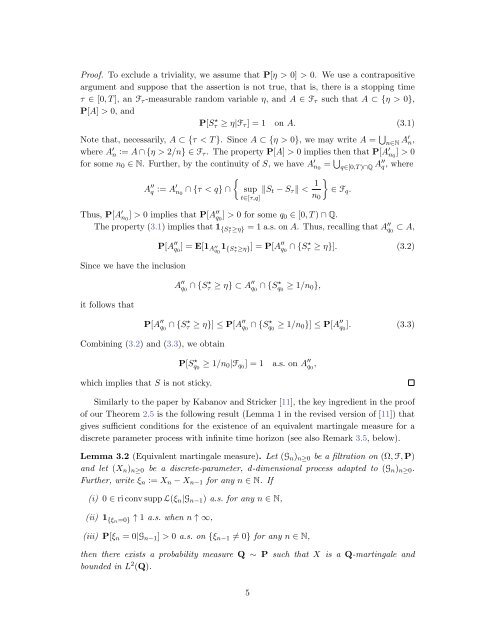Sticky continuous processes have consistent price systems
Sticky continuous processes have consistent price systems
Sticky continuous processes have consistent price systems
You also want an ePaper? Increase the reach of your titles
YUMPU automatically turns print PDFs into web optimized ePapers that Google loves.
Proof. To exclude a triviality, we assume that P[η > 0] > 0. We use a contrapositive<br />
argument and suppose that the assertion is not true, that is, there is a stopping time<br />
τ ∈ [0, T ], an F τ -measurable random variable η, and A ∈ F τ such that A ⊂ {η > 0},<br />
P[A] > 0, and<br />
P[S ⋆ τ ≥ η|F τ ] = 1 on A. (3.1)<br />
Note that, necessarily, A ⊂ {τ < T }. Since A ⊂ {η > 0}, we may write A = ⋃ n∈N A′ n,<br />
where A ′ n := A ∩ {η > 2/n} ∈ F τ . The property P[A] > 0 implies then that P[A ′ n 0<br />
] > 0<br />
for some n 0 ∈ N. Further, by the continuity of S, we <strong>have</strong> A ′ n 0<br />
= ⋃ q∈[0,T )∩Q A′′ q, where<br />
{<br />
A ′′<br />
q := A′ n 0<br />
∩ {τ < q} ∩<br />
sup ‖S t − S τ ‖ < 1 }<br />
∈ F q .<br />
t∈[τ,q]<br />
n 0<br />
Thus, P[A ′ n 0<br />
] > 0 implies that P[A ′′<br />
q 0<br />
] > 0 for some q 0 ∈ [0, T ) ∩ Q.<br />
The property (3.1) implies that 1 {S ⋆ τ ≥η} = 1 a.s. on A. Thus, recalling that A ′′<br />
q 0<br />
⊂ A,<br />
Since we <strong>have</strong> the inclusion<br />
it follows that<br />
P[A ′′<br />
q 0<br />
] = E[1 A ′′<br />
q 0<br />
1 {S ⋆ τ ≥η}] = P[A ′′<br />
q 0<br />
∩ {S ⋆ τ ≥ η}]. (3.2)<br />
A ′′<br />
q 0<br />
∩ {S ⋆ τ ≥ η} ⊂ A ′′<br />
q 0<br />
∩ {S ⋆ q 0<br />
≥ 1/n 0 },<br />
P[A ′′<br />
q 0<br />
∩ {S ⋆ τ ≥ η}] ≤ P[A ′′<br />
q 0<br />
∩ {S ⋆ q 0<br />
≥ 1/n 0 }] ≤ P[A ′′<br />
q 0<br />
]. (3.3)<br />
Combining (3.2) and (3.3), we obtain<br />
which implies that S is not sticky.<br />
P[S ⋆ q 0<br />
≥ 1/n 0 |F q0 ] = 1 a.s. on A ′′<br />
q 0<br />
,<br />
Similarly to the paper by Kabanov and Stricker [11], the key ingredient in the proof<br />
of our Theorem 2.5 is the following result (Lemma 1 in the revised version of [11]) that<br />
gives sufficient conditions for the existence of an equivalent martingale measure for a<br />
discrete parameter process with infinite time horizon (see also Remark 3.5, below).<br />
Lemma 3.2 (Equivalent martingale measure). Let (G n ) n≥0 be a filtration on (Ω, F, P)<br />
and let (X n ) n≥0 be a discrete-parameter, d-dimensional process adapted to (G n ) n≥0 .<br />
Further, write ξ n := X n − X n−1 for any n ∈ N. If<br />
(i) 0 ∈ ri conv supp L(ξ n |G n−1 ) a.s. for any n ∈ N,<br />
(ii) 1 {ξn=0} ↑ 1 a.s. when n ↑ ∞,<br />
(iii) P[ξ n = 0|G n−1 ] > 0 a.s. on {ξ n−1 ≠ 0} for any n ∈ N,<br />
then there exists a probability measure Q ∼ P such that X is a Q-martingale and<br />
bounded in L 2 (Q).<br />
5
















